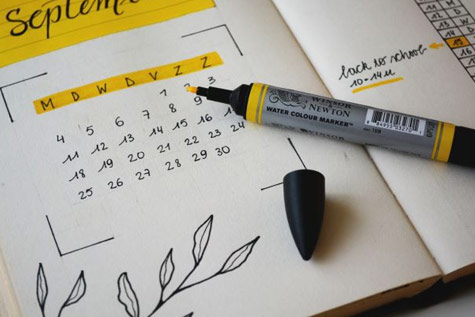In the new year, many of us resolve to do things differently, like take better care of ourselves or be more patient at work. Unfortunately, we like to think and talk about making these changes rather than actually doing something differently. This is one of the reasons so few of us keep our resolutions. Why not scrap them and try something that works?
It turns out we can’t think our way to positive, lasting change. We need to behave differently, and the 30-day practice can facilitate that shift in behavior. In part 1 of this article, you can get an introduction to the 30-day practice – what it is, why you should create one, and how I’ve led successful 30-day practices.
This is part 2. It offers a step-by-step guide to setting one up and gaining insights and tips from experienced 30-day practice enthusiasts who have improved our health, boosted relationships, and completed meaningful projects.
Why Is Habit Change So Difficult?

Even a small change like getting to bed 15 minutes earlier can be a challenge. The habits you currently have, harmful or helpful, in your brain are like the snow tracks created from sledding down a slope over and over. In Norman Doidge’s book The Brain That Changes Itself, the metaphor continues:
“…if you spend your entire afternoon sledding down, walking up, sledding down…there will be tracks that you have created, and it is very difficult now to get out of those tracks. And those tracks are not genetically determined anymore.”
These mental “tracks” lead to habits. The habits can be harmful or helpful but the process is the same and they are often difficult to change. For instance, if you develop poor posture that’s difficult to correct.
The 30-Day Practice Can Help
The good news is you can create new tracks that lead to healthful habits through repetition and time. How much time depends on the person and the desired change. Habit change can take from a few weeks to a few months or longer. The 30-day practice can get you started on the path to positive, lasting change. If you need more time, you can always continue the practice.
How to Set One Up
Below are the steps I suggest for setting up and following a 30-day practice. I incorporated tips and insights I’ve learned from completing over fifty 30-day practices. Each one served as a pathway to better self-care, learning and growing, or attaining meaningful goals.
Choose a Practice
Sounds simple, right? This can be one of the most difficult parts of the practice. Remember, you want to choose a practice that will help you pursue a valued outcome.
For instance, at a particularly difficult time in my life, when suffering through a serious illness, I missed my #2 strength humor and the playfulness that comes with it. Life isn’t always playful, but that didn’t mean I had to choose to be in a dark funk 24/7.

A mentor invited me to step into just two minutes of pure pleasure each day. I accepted the invitation and chose activities that brought that pleasure. Some days it was simply sitting in the warm sunshine for two minutes. Other days it was two minutes of funny videos that made me laugh and enjoy myself.
Over 30 days, two minutes became 5 and then 10. I became more mindful of the lightness, which grew. My practice didn’t cause the darkness to recede, but it boosted my mood and reduced anxiety, even if momentarily. It was like pressing a reset button, which was helpful in my recovery.
Start Small
Initially, choose a 2% or 5% step. These are tiny, doable steps to get you started. Two minutes of pure pleasure was a 2% step. I knew I had 2 minutes to spare daily, and I felt that was doable. Two minutes might sound laughable, and I could have started with 30 minutes, but I knew that wasn’t going to happen. Remember, this is about positive habit formation where the focus is on repeating a particular behavior.
Make It Clear and Specific
You need to know if you took action or not. In my example, I either spent the two minutes or I didn’t. Maybe I spent more or less but the fact that I did it was what mattered.
Build In Accountability

I posted a calendar on my refrigerator and at the end of the day, checked off the days I completed my practice. It was satisfying to do so on the days I did, and I had a visual image of how I was doing overall. You might use a similar method. Or you might instead have a daily check-in with a buddy doing his or her own practice.
Set Reminders to Practice
I can almost guarantee that you will skip days or forget to practice. You might even decide you don’t want to practice. Your practice doesn’t need to be perfect to be effective. Still, the more you practice, the better grooved the “track” becomes. Keep yourself on track by posting sticky notes in a prominent place or setting daily alerts on your phone.
Begin Your Practice Again and Again
When you skip a day, forgive yourself and simply return to your practice. The return is one of the most important elements of your 30-day practice. By returning, you continue grooving those tracks in your brain rather than discounting all the progress you’ve already made. If you have a tendency to berate yourself for not being perfect, perhaps you could focus your next 30-day practice on tempering that overuse of appreciation of beauty and excellence!
Be Flexible
If you have little positive energy around your practice after several weeks, you might need to tweak it or even pivot to another more engaging 30-day practice.
Use Your Character Strengths
Creativity will help you set up the right practice. Prudence will help you plan and schedule practice time. Zest will help you get into action. Self-regulation can help you return to the practice when you skip a few days. Perseverance will help you finish. Humor can help you enjoy yourself along the way. All 24 can help you navigate roadblocks and complete your practice, but your signature strengths might help the most.
Which of your signature strengths might be helpful? If you’re not sure what they are, discover your strengths here or check out my book, a 30-day guided strengths practice, or register for my Power Up session.
I’m Here to Help
I’ve witnesses hundreds 30-day practices helping people introduce positive changes into their lives, from reading more to focusing more time on hobbies, relaxing, writing books, exercising more, reducing sugar intake, drinking more water, and many others.
What would you like your 30-day practice to be about? Make sure it’s something that is important, meaningful, or valuable. It should elicit positive energy in you, not drain you, as you think about it. If it is draining, change it up until it’s energizing.
As you get started, let me know if you’re feeling stuck or confused along the way. I love helping people experience positive changes in their lives! Feel free to contact me.
Keep me posted!
NOTE:
Doidge, N. (2010). The brain that changes itself: Stories of personal triumph from the frontiers of brain science. New York: Penguin Books, p. 209.



